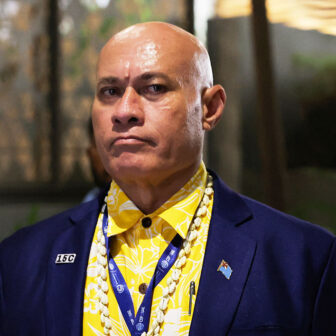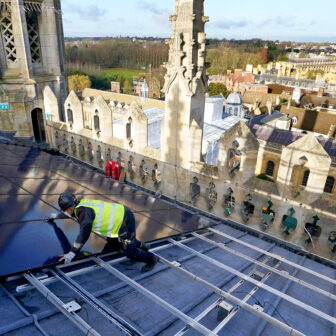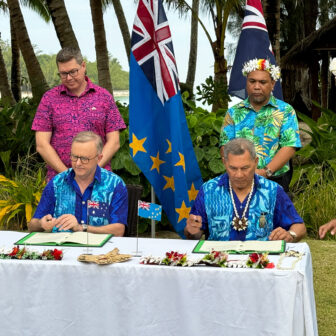An earlier version of this article appeared in Yale Environment 360, published at the Yale School of the Environment.
When head ranger Ikavy Pitatamae walks into the rainforest that is his inheritance on Choiseul Island, the westernmost of the nearly 1000 islands that make up the South Pacific archipelago of Solomon Islands, he surveys it with the heart of a tribal landowner and the eye of a forester.
Leading the way up a track into the bush, he wades into a glassy stream, stirring small, brown fish into a spin. Surveys have identified some fifty freshwater species in these waters, a haven of biodiversity in a nation ravaged by high rates of logging, its forests felled at up to nineteen times the annual sustainable rate. At the sound of a thumping whoosh overhead, Pitatamae points up just as two Papuan hornbills — broad wings pumping behind their extravagant orange beaks — flash across a gap in the canopy.
“They always fly in pairs,” observes Wilko Bosma, a lanky Dutchman trailing behind the ranger. “They’re committed for life.”
Bosma made his own commitment to this forest after landing here twenty-five years ago as an idealistic forestry graduate, working alongside Indigenous tribal landowners on small, sustainable timber projects. That’s how, in 2004, he came to establish with tribal partners a local conservation NGO — the Natural Resources Development Foundation, or NRDF — and got to know Linford Pitatamae, the older brother of ranger Ikavy and a leader of their tribe, the Sirebe.
Together with a handful of neighbouring tribes, the Sirebe have steadfastly resisted offers of quick money from the Malaysian companies whose ships lurk off the coast, piled with logs for export to China. Aerial maps reveal their remarkable success: this is the only expanse of green on the island that is not scarred by logging roads. Just how it’s survived twenty-five years of intensive logging is “a sort of miracle in itself,” says University of Queensland sociologist Kristen Lyons, who’s visited several times for fieldwork. The islands are full of stories of communities that were determined to keep their trees, only to be sold out some dark night in Honiara by one or two rogue players.
“If we misuse or destroy this land, we will not have any other,” explains Linford Pitatamae. “So we have been committed to protect our lands, our forests, our rivers and streams, and all the resources for quite a long time.”
They began working to capitalise on their standing forest in 2015. Four years later, the tribe’s 806 hectare forest became the first legally protected area in the nation, a “beacon of conservation and natural resource management,” according to Culwick Togamana, Solomon Islands’ environment minister.

Tracking the forest: Choiseul Island head ranger Ikavy Pitatamae. Jo Chandler
In February 2022, the Sirebe became the nation’s first landowners to receive payment from international investors for keeping their forests intact. With neighbouring tribes also securing protected areas and selling “high integrity” carbon credits to buyers looking to offset their greenhouse emissions or burnish their green credentials, the Babatana Rainforest Conservation Project — named for the tribes’ shared language group — so far covers 6863 hectares of protected tropical rainforest.
As a high-integrity carbon project, its credits sell at top dollar on global markets. But high integrity is a concept wildly at odds with growing evidence questioning the credibility of many voluntary carbon ventures and the usefulness of the offsets they sell in tackling rising emissions. Recently, the carbon offsets methodology applied most commonly within Australia, and which claimed to regenerate outback forests, was criticised by experts as a failure on a global scale.
The Solomons landowners are now players in the international carbon economy, a complex, controversial enterprise founded on what carbon-market pioneer Mark Trexler describes as “a counter-factual forecast of what would have happened” — that is, logging that did not happen — in the absence of a particular project.
Then there’s the question of how integrity might be measured and defined. Is it about the quality of the empirical data offered to carbon buyers, or is it about the authenticity of its dealings with the forest owners? Can it be both?
Climate experts from across the spectrum — social scientists to market analysts to emissions wranglers, often far from the action — raise a range of concerns about the concept of high-integrity carbon. Indigenous landowners are custodians of some of the last great rainforests in the world, including here in the Pacific. How does it look to them, up close, this business of growing money on trees?
It takes some doing to find this forest. From the national capital of Honiara a workhorse Twin Otter makes the two-hour, inter-island hop to Taro, capital of Choiseul Province. The airstrip runs the full breadth of the tiny atoll. It’s so exposed to rising seas and tsunamis that plans are (slowly) underway to move the town and its 1000 residents to higher ground.
Then, in kind seas and with a hard-working outboard, another three hours by dinghy along the south coast, passing scarred coasts, filthy logging ponds and huge, rusty ships waiting on more trees. Then, turning inland, slowing to motor up the shallows of the Kolombangara River, before the boat pulls up at the Sirebe protected area where the rangers head out on patrol.
Ikavy Pitatamae opens his phone to record his sighting of the hornbills in a biodiversity app, then uploads a photograph of a fallen tree into another app used for tracking changes in forest conditions.
The calculations underwriting the value of this project on the international carbon market began with the rangers conducting painstaking surveys over six months. They measured everything growing and living within a list of survey sites twenty-five metres in diameter. Rangers repeat the surveys every ten years, annually conduct transect surveys that record every change and every animal spotted and routinely patrol boundaries, checking for incursions. Reports are verified by independent auditors and against satellite imagery.
Pushing through the dense tangle of vines and shrubs to the base of a giant brown terminalia tree, Ikavy Pitatamae demonstrates how baseline data are collected. He passes a measuring tape around the tree’s girth, then aims a laser beam up to where the trunk — likely 200 years in the making — branches out. Loggers would covet this specimen.
Pitatamae’s data points verify that this forest contains harvestable and marketable timber that would probably be felled were it not protected — thus demonstrating a core carbon market requirement that the trees would not otherwise exist without this project. The data are also necessary for tallying the forest’s carbon store, or inventory — the bottom line of the product, the credits, sold on the carbon market. Variables are incorporated to account for what would happen if it was cut. If a log ends up as a piece of furniture, for instance, much of its carbon says locked up for many years. If it becomes particle board or pulp — the fate of most of the round Solomons logs sold to China — it will be released earlier.

Profit for purpose: Sirebe rangers patrolling the forest. Douglas Junior Pikacha/Nakau
The magnificent canopy, the forest’s messy middle story of young trees and saplings, and the biomass of its understory would all be just collateral damage to loggers coming for this tree’s trunk. But left standing, they are a high-value part of the complex calculus paying the rangers’ wages and supporting their families.
Since 2022, the Sirebe have received five quarterly payments for their forest project and a sixth is due anytime. The money should keep flowing until 2045, when the contract comes up for renewal. The payments are made by Nakau, the Pacific-wide, rights-based, “profit-for-purpose” social enterprise (profits are reinvested in projects) that coordinates the Babatana project and works in collaboration with NRDF. Similar payments are in the pipeline for neighbouring tribes as their projects are verified and added to the Babatana project portfolio.
The Babatana project is owned by the tribes, who also retain their carbon rights. This structure seeks to overcome some of the criticisms aimed at other carbon-trading schemes internationally, including that they perpetuate extractive colonial dynamics in their dealings with forest people and have led to episodes of conflict and violent dispossession. Many experts have been damning of projects’ lack of consultation with local people and transparency, and there is substantial evidence that some projects are pure greenwashing.
Among those critics is Kristen Lyons, a sustainability and development expert who spent years observing projects in East Africa that failed to deliver what they promised. With her UQ colleague Peter Walters she’s taken the position that carbon offsets not only enable big industrial polluters to continue emitting, but they also recruit traditional landowners “as unwitting accomplices to this environmental procrastination,” as the scholars wrote in a 2021 book chapter. While carbon projects don’t wreak the same immediate devastation on landscapes as logging and mining, if they allow emitters to keep on emitting then they might as well.
Nonetheless, after several years of monitoring the Solomons project, Lyons and Walters say it is a regionally significant example of best practice for carbon projects in a small nation. “I have been, historically, incredibly critical of carbon offset projects,” Lyons says. But after applying an environmental justice lens to her study of the Babatana project, she notes, “My view has shifted.”
Lyons observes that while forest owners should, in theory, be powerful stakeholders in a global market worth hundreds of billions of dollars, in reality they are often far from equal partners. Indigenous people may struggle with impenetrable jargon from the wrong side of the digital divide, often in their third or fourth language.
But on Choiseul Island, local engagement is strong. Lyons says she has seen communities using money received from the offsets for programs that reflect their own priorities, including agricultural, sanitation and education projects. It’s delivering sustainable livelihoods grounded in principles of cooperation, collective ownership, and maintenance of customary law alongside some quite radical changes in the delivery of money directly to women. It “points to the vital role of centring forests for life, not simply forests for markets,” says Lyons. The community has been tactical and careful, so even if the carbon caper goes belly up tomorrow, it will have delivered lasting benefits.
“I don’t hold the view that carbon offset projects are the answer to responding to the challenge of climate change,” she says. “But I do hold the view that we need to attend to human rights, particularly Indigenous rights, at the same time as we’re seeking to attend to the climate crisis.
“And so, if local communities — particularly Indigenous communities — are saying this is a pathway for us that we want to explore… I think it would be a terrible thing if there was not the support. Or worse, if there was the curtailment that we saw all carbon offset projects as bad, and therefore denied the rights of Indigenous people.”
Their morning’s work in the forest completed, the Pitatamae brothers and Bosma climb are aboard their dinghy, the outboard barely working, as they slowly navigate back down the shallows of the Kolombangara River past crocodiles, kingfishers and flood-eroded banks.
Big rains used to come once a season but now occur five or six times in succession, says Linford Pitatamae. The damage is far worse in logged areas, where floods wash out crops and sediment contaminates clean water and coastal fishing grounds.
This river flows through 87,000 hectares of lowland, riparian and montane forests that contain some of the richest biodiversity remaining in Solomon Islands. On the northern bank lies the 4800 hectare protected area of the Padezaka tribe, whose carbon project is in its last stages of verification. “This area is heavily threatened by logging,” Bosma says. “It’s been quite an achievement that they could get it [protected] in time.” Some neighbouring tribes have let loggers in, and muck from the churned landscape, logging camps and roads is spilling into the water catchment.

High-tech tracker: ranger Elijah Qalolilio Jnr uses a smartphone app to monitor of the forest. Douglas Junior Pikacha/Nakau
Leaving the river, the canoe picks up speed for the last bumpy leg home over open ocean, finally pulling up on the sand at Sasamungga, the midpoint of Choiseul’s south coast.
The sprawling village is home to around 1000 people from the Sirebe, Siporae, Vuri, Padezaka, Garasa and Lukulombere tribes, whose ancestral forests are inland, in the river country we’ve just left. Like many Pacific forest people, they have drifted over the decades to hubs like Sasamungga to access education, markets, health services, transportation and jobs.
Only about 10 per cent of the small but growing Sirebe population have paid employment outside the village, says Linford Pitatamae, so most of the community have had a hand-to-mouth village life, relying on what they could earn from fishing and agriculture. Now, their carbon project sells around 17,423 credits a year on the international market under a deal extending thirty years. It takes in roughly $263,350 a year, of which 20 per cent goes to NRDF, 20 per cent to Nakau, the project coordinator, and 60 per cent to the twenty-seven households of the project owners. In a subsistence economy in one of the poorest nations in the Pacific, that’s life-changing income.
One man put his household’s share into a new outboard motor and insulated boxes to store fish for sale. His neighbour invested in equipment for a mechanical workshop. Families have installed solar panels and toilets with septic tanks, upgraded their homes, and plumbed water taps that deliver rainwater collected in new tanks.
Five per cent of payments — $2360 every quarter — go into the Sirebe women’s savings club. Karah Qalo, who founded the club, says the thirty-three members use it to pay their children’s school fees, buy materials for their food gardens, invest in bakery projects and bee keeping, and run their phones.
Their situation is radically different from that of women from forest communities that have been logged. Local custom largely holds that only men have authority over the land, while women have only the right to use the land — including for gardening, firewood or water collection. When male leaders allow loggers in, says Qalo, they get cash but the women lose everything. “The water will be polluted, air pollution, everything will not be good because of the pollution of the machines.”
Carbon marketeers usually describe the carbon that is sequestered and traded as the core benefit of their business and any positive social or economic outcomes for local people as co-benefits. But Nakau chief operating officer Alex McClean argues that from the perspective of forest people, “the carbon is close to irrelevant. What matters to them are improvements to their life and livelihoods.” He likes to turn the measure of integrity on its head, so things like jobs for rangers and funds that empower women become core benefits, with carbon reduction the icing on the cake.
But carbon market pioneer Mark Trexler, while not commenting specifically on the Nakau model, questions this approach, and the application of an environmental justice lens to carbon projects. “‘High integrity’ in the offset space has to refer to climate change mitigation benefits,” he says, not to co-benefits including forest community impacts. “If voluntary markets become seen primarily as a way to send money to impacted communities, we’re talking about carbon contributions, not offsets.”

“A sort of miracle”: the Sirebe forest at dusk. Douglas Junior Pikacha/Nakau
Trexler’s involvement with the carbon market goes back to its beginnings in 1988, and while in principle he believes designing a high-integrity market is possible, “In practice, we don’t seem to be able to do that.” The core stumbling block is the tension between cost effectiveness and environmental integrity. The rules and outcomes for a low-cost offset market will look entirely different from the rules for a high-integrity market, he says. “Obviously some buyers are willing to pay top dollar. But the market as a whole is characterised by ridiculously low prices that can’t possibly represent real offsets. And there is very little appetite for lifting the entire market into integrity territory, in terms of prices.”
Nakau chief executive Robbie Henderson says demand for the Babatana project is strong and that “we could definitely sell our credits several times over at the moment.” Some buyers don’t use those credits to offset anything, he says, but rather to demonstrate their environmental commitment. Some agree not to claim carbon neutrality; some offset residual emissions. An exclusion list prohibits the sale of credits by its biggest buyer to support any fossil fuel expansion.
Linford Pitatamae recalls plenty of scepticism when he and Wilko Bosma started talking to the community about the crazy notion of selling their forest, but not their trees. “At first, we didn’t think this was a real project,” he says. “The community didn’t really understand.” It took years of “continuous engagement, training, [and raising] awareness” to win support, he says, then more years to work through the hurdles of verification and certification to get to this point. Now he’s hearing from landowners across the island, and the nation, who are hungry to learn more.
“We believe we have to respect the environment — that will bring us a good future,” Pitatamae says. “We still have our trees [and] good drinking water sources. Our birds are still there. Our sacred places are still there.” He spends long hours most days locked away from the forest he loves, grinding through the paperwork and complexities of keeping this enterprise going. But he’s not complaining.
“This is the right path for rural Solomons to follow,” he says. •




